



Picture books: a tool to develop cultural awareness in the languages classroom with Nathalie Paris www.nattalingo.co.uk Podcast: Nattalingo’s natter Twitter: @Nattalingo Facebook: @nattalingo LinkedIn: Nathalie Paris YouTube: Nattalingo Productions
Picture books: a tool to develop cultural awareness in the languages classroom We will be looking at books which were written specifically to cover certain cultural aspects, like celebrations; we will explore other books, like fairy tales, which can give us cultural clues; we will also look for more subtle clues in authentic stories. 1) A definition of culture and its proficiency continuum
What constitutes culture? Following the U.S. National Standards for Foreign Language Learning, (1996, p. 43) we adhere to the tripartite model that divides culture in: 1) Products , 2) Practices and 3) Perspectives . 1.Products : things created by a particular culture (books, tools, foods, laws, music, games) 2.Practices : patterns of social interaction (patterns of social interactions) 3.Perspectives : represent a culture´s view of the world (meanings, attitudes, values, ideas) This model is an effective stepping stone to consider an intercultural approach to teaching and learning a foreign language in the young learner´s class. How can we use the model? See below for an example of how this model might be used to explore various themes. Theme: Food Theme: Soccer Identify elements Identify the name to play soccer Products of meals and (soccer ball, soccer traditional food field, goal, etc.) Display correct Describe a soccer table manners and game /use Practices verbal expressions vocabulary related at a table (real or Future Learn course THE ART OF TEACHING FOREIGN to soccer role-play) LANGUAGES TO YOUNG LEARNERS Recognise and Recognise and UNIVERSIDAD NACIONAL DE CÓRDOBA Perspectives develop attitudes develop attitudes https://www.futurelearn.com/courses/teaching-foreign- toward food toward soccer languages/2/todo/40530
• Intercultural competence is demonstrated through the interaction between the use of language and cultural knowledge. Through contact with products (types of houses, dresses, educational systems) and practices (greetings, playing behaviours) shown by people, we come to understand their perspectives (values, beliefs, attitudes, etc.). • Just as we establish proficiency levels (degrees of ability/ expertise) when we learn a foreign language, so we can assume that levels of intercultural competence exist. At a beginner level, children will be able to identify (sports), recognize (leisure activities) and imitate (greetings). As we move up into the intermediate band, children will be able to talk (about a singer) or describe (a festival) or respond in a culturally appropriate way (expressing wishes). At a higher range, children will be able to compare (eating habits), explain and analyze (tradition, fashion, etc.) • In this way learners continually add to their knowledge as they move up the language and culture proficiency continuum. • Books as a product are part of the culture
Picture books: a tool to develop cultural awareness in the languages classroom We will be looking at books which were written specifically to cover certain cultural aspects, like celebrations; we will explore other books, like fairy tales, which can give us cultural clues; we will also look for more subtle clues in authentic stories. 2) Books about culture • In English • In the target language 3) Fairy tales, myths and legends 4) Other authentic stories
Picture books: a tool to develop cultural awareness in the languages classroom We will be looking at books which were written specifically to cover certain cultural aspects, like celebrations; we will explore other books, like fairy tales, which can give us cultural clues; we will also look for more subtle clues in authentic stories. 2) Books about culture (beware of stereotypes!) • In English: Clare Seccombe’s blog http://changing- phase.blogspot.com/search?q=culture ; “France for kids” and “The fantastic French” , bonhomme de chemin publications (both also available in French) • In the target language: specific places, events/festivals/times of year eg back to school; “Pip und Posy und der Weihnachtsbaum ”, Axel Scheffler ; “Book Fiesta” (bilingual), Pat Mora & Rafael López; “Le loup qui voulait faire le tour du monde”, Orianne Lallemand & Éléonore Thuillier; “ Où est mon chat?”, Princesse Camcam (on Paris)
Picture books: a tool to develop cultural awareness in the languages classroom We will be looking at books which were written specifically to cover certain cultural aspects, like celebrations; we will explore other books, like fairy tales, which can give us cultural clues; we will also look for more subtle clues in authentic stories. 3) Fairy tales, myths and legends: to point out fixed culture and changeable aspects of culture 4) Other authentic stories • “Petite taupe ouvre-moi ta porte !”, Orianne Lallemand & Claire Frossard – read story! lets people into her house; very common to have visitors in France and entertain them; soupe à l’oignon inc story of my wedding and photo • “Otto: autobiographie d’un ours en peluche ”, Tomi Ungerer (historical) • “Le meilleur resto du monde”, Dorothée de Monfreid (food) • “1,2,3,4 pattes ”, Soledad Bravi (many cultural references)
• “Le popo du chiot ”, Jeong-Saeng & Seung-Gak Jeong ; “Je peux le faire”, Satoe Tone ( Japanese philosophy) • “Il y a des jours …”, Mies van Hout, Géraldine Elshner & Claire Teyras (huge work by translators, clin d’oeil aux traducteurs) • “Un culete independiente ”, José Luis Cortés & Avi • “ Vom kleinen Maulwurf, der wissen wollte, wer ihm auf den Kopf gemacht hat”, Werner Holzwarth & Wolf Erlbruch
This was… Picture books: a tool to develop cultural awareness in the languages classroom with Nathalie Paris MERCI! THANK YOU! www.nattalingo.co.uk Podcast: Nattalingo’s natter DANKE SCHÖN! ¡GRACIAS! Twitter: @Nattalingo Facebook: @nattalingo LinkedIn: Nathalie Paris YouTube: Nattalingo Productions
Recommend
More recommend